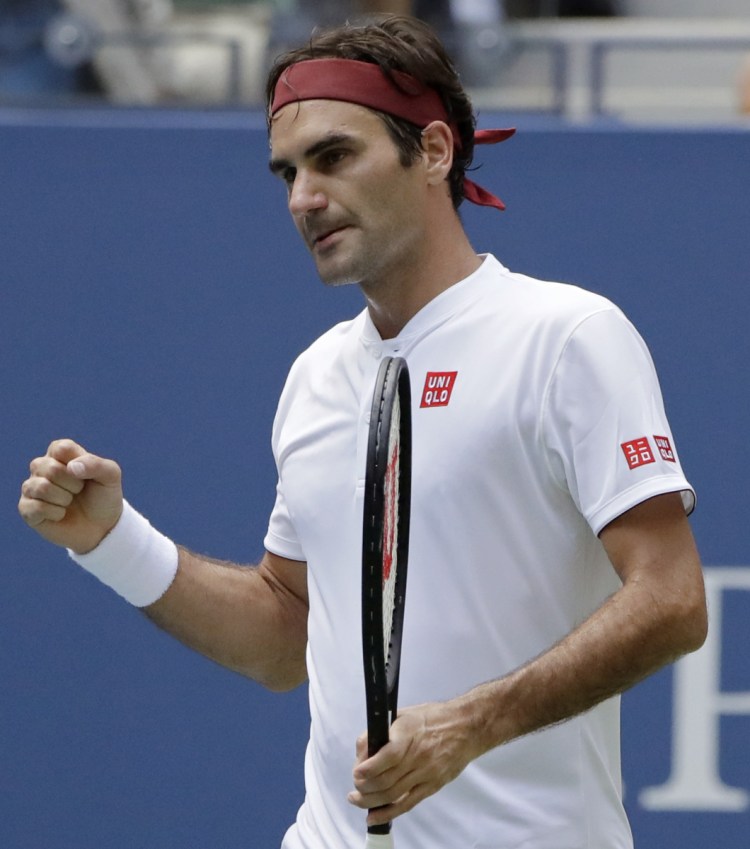NEW YORK — The most pivotal part of Roger Federer’s U.S. Open victory over Nick Kyrgios, both agreed, came all of 17 minutes in, when the 20-time major champion was serving at 3-all, love-40 and got out of the jam.
The most spectacular part? That was, anyone who saw it surely would agree, the on-a-full-sprint, drop-shot-retrieving, flick-from-a-few-inches-off-the-ground, forehand-around-the-net-post, jaw-dropping winner that Federer conjured up close to the conclusion of the 6-4, 6-1, 7-5 tour de force in the third round Saturday.
“Almost unreal,” said Kyrgios, who admired the bit of racket wizardry with eyes wide open and mouth agape.
“A special one, no doubt about it,” said Federer, who put it up there among his greatest hits, which, is saying something.
Much was made of Kyrgios’ previous match, in which chair umpire Mohamed Lahyani climbed out of his seat to have a chat with the 23-year-old about whether he was giving his best while trailing by a set and a break. Kyrgios went on to win; Lahyani was chastised by the U.S. Tennis Association for breaching “protocol” but allowed to continue at the tourney.
This time, of course, Kyrgios received no counsel other than all the muttering, at various volumes, at himself. He doesn’t have a coach and wondered aloud, during the latest in a long line of news conferences that sound more like therapy sessions, whether he should add one – or perhaps someone who could help with the mental aspect of the game.
Federer alluded to one particularly questionable choice Kyrgios made at 5-all, 40-15 in the final set, when he went for a drop shot that found the net instead of simply hitting a normal forehand into the open court.
“Clearly,” Federer said, “when you play that way and you lose, it’s always, like, you feel like he’s so much to blame. But that’s just how he plays.”
The contrast between Kyrgios’ mindset and Federer’s was not lost on the talented, if temperamental, Australian.
“We’re two very different characters. Just the way he goes about things, I could take a leaf out of his book. The way he behaves on court. His demeanor,” the 30th-seeded Kyrgios said. “I don’t want to change myself too much, but I could definitely take away things he does in certain situations. He’s the ultimate role model to anyone who wants to play.”
The No. 2-seeded Federer moved into the fourth round at Flushing Meadows for the 17th consecutive appearance. He’s won five titles at the U.S Open, although the last arrived a decade ago.
Next is what shapes up as a mismatch, facing 55th-ranked John Millman, who never before has made it this far at any Grand Slam tournament.
In women’s action, there was a series of surprises, highlighted by Wimbledon champion Angelique Kerber’s 3-6, 6-3, 6-3 loss to No. 29 Dominika Cibulkova. Kerber, who counts the 2016 U.S. Open among her three Grand Slam trophies, was seeded No. 4, and joins No. 1 Simona Halep and No. 2 Caroline Wozniacki in making Week 1 exits.
No. 6 Caroline Garcia and No. 13 Kiki Bertens also lost, while 2017 runner-up Madison Keys came back to beat Aleksandra Krunic, 4-6, 6-1, 6-2.
Also, five-time major champion Maria Sharapova improved to 23-0 in U.S. Open night matches and returned to the fourth round by beating No. 10 seed Jelena Ostapenko, 6-3, 6-2.
Copy the Story LinkSend questions/comments to the editors.



Success. Please wait for the page to reload. If the page does not reload within 5 seconds, please refresh the page.
Enter your email and password to access comments.
Hi, to comment on stories you must . This profile is in addition to your subscription and website login.
Already have a commenting profile? .
Invalid username/password.
Please check your email to confirm and complete your registration.
Only subscribers are eligible to post comments. Please subscribe or login first for digital access. Here’s why.
Use the form below to reset your password. When you've submitted your account email, we will send an email with a reset code.